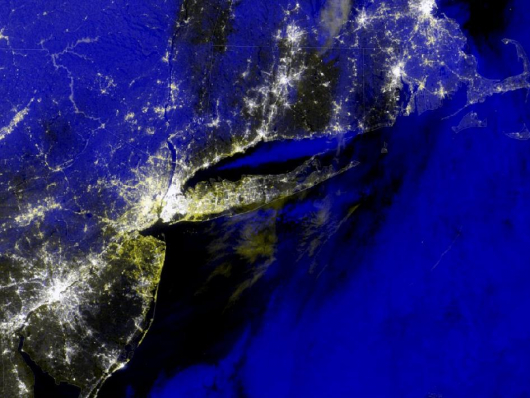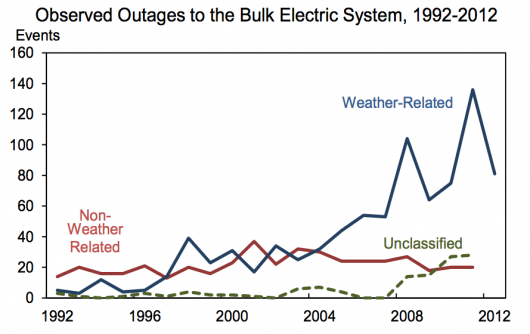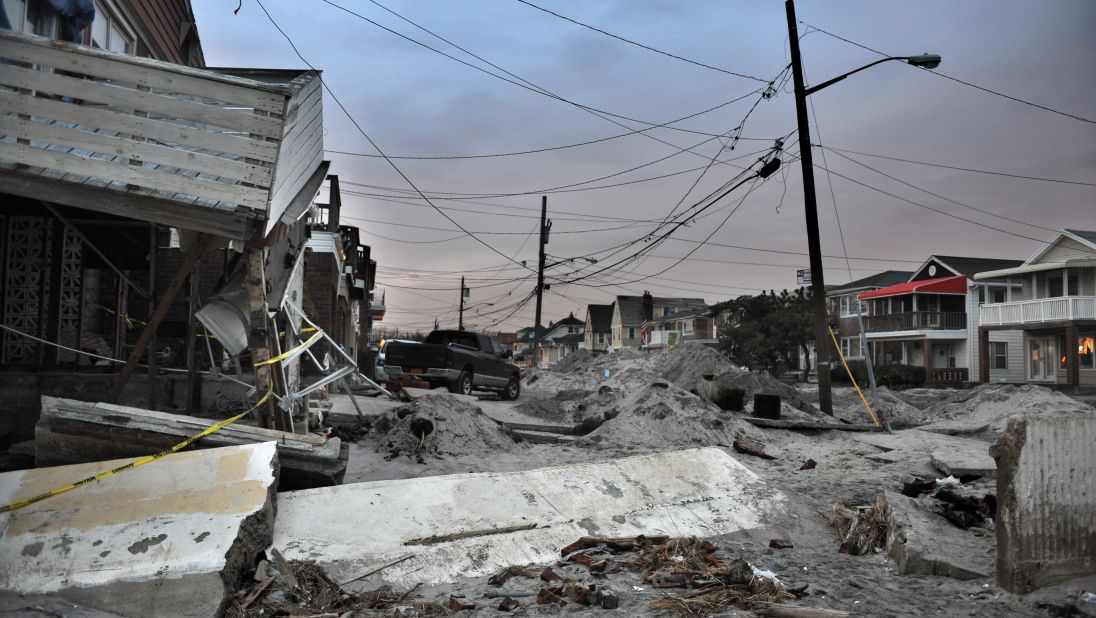Superstorm Sandy was arguably one of the most significant storms in the history of the U.S. power sector. It was not a worst-case scenario. It was not the most expensive. And it was not the deadliest. But a confluence of factors made Sandy into an extraordinary event with a deep and lasting impact on how American utilities think about the future of the electric grid.
Extreme weather is a normal part of doing business in the power sector. Ever since America began putting up poles and wires to electrify the nation in the late 19th and early 20th centuries, wind, rain, ice and lightning have been there to knock them down.
While not as commonplace as they are in the Southeast, hurricanes in the Northeast have threatened utilities since the dawn of the electric era. In the earliest days of the power grid, from the late 1880s to early 1890s, tropical storms and snowstorms wreaked havoc on the tangled network of electrical wires hanging above New York City. Decades later, as the electricity system expanded widely outside urban areas, the Great New England Hurricane of 1938 -- a Category 3 storm more powerful than Sandy at landfall -- caused outages for tens of thousands in Connecticut, Massachusetts, New York, New Hampshire and Vermont that lasted for weeks.
Over the last century, dozens of hurricanes and tropical storms, snow and ice storms, and other extreme weather events have damaged the Northeastern grid and forced massive outages. In other regions of the U.S., tornadoes, hurricanes, hail and wildfires remain a constant threat to the electricity system. All utilities deal with these threats and must build weather risks into their planning. Some do it far more effectively than others.
So if extreme weather planning is already such an integral piece of the power sector, why revisit the story of Sandy?
“Sandy was a watershed event for the industry in terms of planning. It was a wake-up call.” Peter Fox-Penner, The Brattle Group
A combination of size, scope and timing set Sandy apart from past events that have caused trouble for the grid. Consequently, in the year and a half since the storm ravaged the East Coast, there’s been a meaningful shift in the way that utilities, regulators and policymakers talk about the electricity system.
Tens of billions of dollars have been proposed or spent to modernize the grid; power companies have become more vocal about factoring climate change into planning; and new smart grid technologies have proven their value to the electricity system. Meanwhile, utilities are witnessing the beginning of a structural change to their business models as clean, distributed generation becomes more competitive -- in turn influencing the way regulators think about grid resiliency.
“I think Sandy was a watershed event for the industry in terms of planning,” said Peter Fox-Penner, a utility expert and principal with the Brattle Group, an economic consulting group in Washington. “It was a wake-up call.”
The most obvious differentiator was Sandy’s timing. The storm hit the highest populated area of the U.S. at high tide -- just as a large nor’easter made its way over to the East Coast and a high-pressure system forced the mixing systems to slow down. It was an unprecedented series of meteorological events.
When the storm finally dissipated over the Great Lakes, it left 8.5 million people without power in twenty-one states -- the highest outage total for any U.S. extreme weather event in history. Sandy didn’t cause the same level of displacement and economic destruction as Hurricane Katrina seven years earlier, but it was the second-costliest hurricane ever to hit America. It caused $65 billion in damage and took the lives of 117 people in the U.S.

Photo Credit: NASA. Yellow regions show urban areas that lost power during Sandy.
It wasn’t just the record-breaking outages and damage figures that made Sandy so unique. The storm followed three major extreme weather events on the East Coast in the preceding eighteen months that each caused outages for millions of people.
In August 2011, Hurricane Irene cut power for 4 million people on the Eastern Seaboard, causing $15.6 billion in total damages. A few months later, a Halloween nor’easter caused more than outages for more than 3 million people in the Mid-Atlantic and Northeast. And then, in June 2012, a powerful wind storm called a “derecho” carved a 600-mile path through the Mid-Atlantic and Midwest, bringing 91 mph winds and causing outages for more than 4 million people.
“It was kind of off the charts,” said Fox-Penner. “I think it changed everybody’s outlook.”
That series of events was part of a long-term trend. Since the 1980s, there has been a documented increase in the number of U.S. power outages due to extreme weather. According to the U.S. Energy Information Administration, weather caused 87 percent of the outages that impacted more than 50,000 customers between 2002 and 2012 -- including rainstorms, hurricanes, snowstorms, wildfires and extreme temperatures. In 2011, the U.S. was hit with fourteen weather disasters causing more than $1 billion in damage each. And 2012 brought eleven events costing more than $1 billion each.
“We've seen a lot of unprecedented weather events in recent years -- Sandy being one of them,” said Jeff Masters, a meteorologist with the commercial weather service Weather Underground. “When you start seeing unprecedented weather events more numerously, then you need to ask yourself, ‘Is the change in our weather and climate partially responsible?’ And I think the answer has to be ‘Yes.’”
A recent report from independent think tank Climate Central documented the surge in weather-related threats. Since 1951, heavy downpours have increased in the Northeast by 74 percent, in the Midwest by 45 percent and in the Southeast by 26 percent. In the West, where there were more heat waves in the 2000s than in any decade over the last century, wildfires have increased by 40 percent. And since the 1980s, there has been an increase in the number and strength of Category 4 and 5 hurricanes forming in the Atlantic Ocean.

Photo Credit: EIA. Documenting the surge in weather-related “grid disturbances.”
Faced with this growing problem, regulators are considering how to integrate climate science into long-term planning -- a move that could help reshape the way electricity infrastructure is built through the middle of the century.
With the average power plant now more than 30 years old, the average transformer more than 40 years old and the average transmission line more than 25 years old, there will be a significant turnover of grid infrastructure in the coming years. Adding climate considerations into the planning process will accelerate adoption of information technology (IT), operational technology (OT), grid hardening techniques and distributed generation.
There’s a third factor making power outages like those caused by Sandy different than in the past: changing customer demands. America’s power consumption has flatlined in recent years due to an economic slowdown, structural change in the industrial sector and economy-wide efficiency improvements. But the need for constant connectivity has made electricity an even more valuable commodity.
After Sandy, thousands of New Yorkers ventured northward from Manhattan looking for places to charge computers and cell phones. Some walked more than 50 blocks to locate a working outlet or a coffee shop with functioning internet service. Throughout New York and New Jersey, mobile charging stations -- some powered by solar -- were set up to help get basic power services to “digital refugees.”
Expectations of constant connectivity have changed the public’s perception of utilities. At a time when businesses can track virtually any product in real time, customers became increasingly frustrated after Sandy when power companies couldn’t give them an accurate timeline for restoration. Many people reported seeing crews unfolding paper maps and scribbling notes manually; others said they talked with out-of-state lineworkers who had no details as to when a neighborhood would be electrified.
“The situation seemed pretty ridiculous in modern America,” according to Scott Olson, the deputy mayor of Byram Township, New Jersey, describing his thoughts as he watched crews comparing paper road maps with utility infrastructure maps.
For a discussion on how utilities are adopting smarter technologies to deal with extreme weather-related outages, listen to the Energy Gang podcast below:
In the weeks after the storm, public officials criticized utilities for their slow restoration times and seeming ineptitude. The reality, however, is more complicated. An analysis one month after the storm showed that power restoration was faster than average -- even though Sandy was worse than any storm East Coast utilities had ever faced.
Using data from Ventyx, a company that provides industrial software and analytics provider for utilities and other heavy industries, the Associated Press found that power companies were able to restore electricity to customers faster than after any major hurricane or tropical storm since 2004. This is because utilities -- despite their slow adoption of new technologies -- have started investing in 21st-century hardware and software to better monitor and control the grid.
“When you start seeing unprecedented weather events more numerously, then you need to ask yourself, ‘Is the change in our weather and climate partially responsible?’ And I think the answer has to be ‘Yes.’” Jeff Masters, Weather Underground
Sandy highlighted some glaring vulnerabilities in the way utilities manage the electricity system and communicate with customers. But it also helped build momentum for another round of spending on innovative technologies. According to a 2013 survey from the global management and technology firm Accenture, 83 percent of utilities in North America said that recent extreme weather had directly influenced investment in technologies to network the grid.
“This is now a top priority,” said Jack Azagury, head of Accenture’s global smart grid business. “We saw Sandy give the utilities an environment to consider broader investment” in smart meters, fault detection and software tools to monitor the distribution grid.
Nearly two years after the storm, a new buzzword has emerged as a framework for this next round of investment: “resiliency.”
The National Association of Regulatory Utility Commissioners defines resilience as “robustness and recovery characteristics of utility infrastructure and operations, which avoid or minimize interruptions of service during an extraordinary and hazardous event.”
The term is not new for the power sector. But it’s taken on a more urgent meaning within utility boardrooms, regulatory proceedings, government agencies and the technology companies. It is partially driving the business plans of East Coast utilities -- and consequently spreading throughout the U.S. to influence the broader power sector. Although resiliency is only one lens through which power companies view the world, it has arguably become a central one for many of them.
“We’re seeing this convergence of three things: power outages from increasing extreme weather combined with emerging technology solutions and changing business models. Those are driven in large part by resiliency planning,” explained Lewis Milford, president of the Clean Energy Group, a nonprofit clean energy advocacy organization. “We’ve seen a pretty dramatic response to Sandy and other weather events.”
This is the story of how power providers are adapting their businesses through that lens in a post-Sandy world. Download the free eBook today.



